Our Latest Blogs
Our Solutions News Blog was envisioned to gather and share information from the very best to help you and your business to become more effective.
Our Solutions News Blog was envisioned to gather and share information from the very best to help you and your business to become more effective.

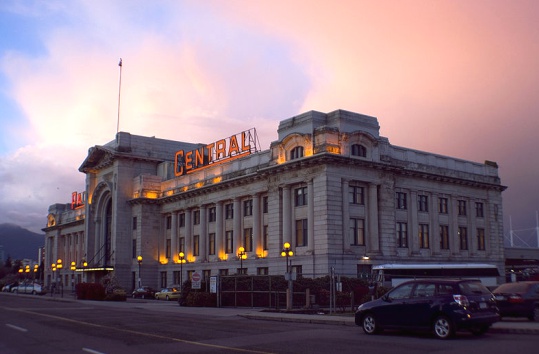
There are about 2,150 registered heritage buildings in Vancouver, plus 131 parks and trees, and additional monuments and archaeological sites.
You can find all of these heritage sites in the Vancouver Heritage Register (VHR).
The City's long term goal is to protect, through voluntary designation, as many resources on the Vancouver Heritage Register as possible.
How does a site qualify for inclusion?
To be included in the VHR:
Click Here » to find out more.
Also view Wikipedia » to view listed properties.
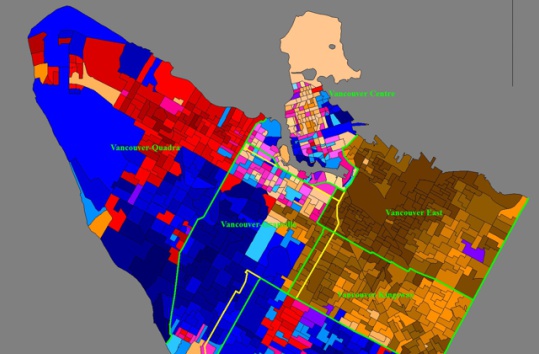
The boundaries of the City of Vancouver are not simple, check out their complicated description from the Vancouver Charter below. Does this make any sense to you?
Commencing at a point in the First Narrows of Burrard Inlet, which point is eight hundred (800) feet distant northerly, measured along a line astronomically north from the light in Prospect Point Lighthouse; thence south-easterly in a straight line to a point in Burrard Inlet on the production northerly of the boundary between District Lot Five hundred and forty-one (541) and District Lot One hundred and eighty-five (185), which point is situate at the intersection of the said production with the straight line from the light in Brockton Point Lighthouse to a point in the Second Narrows of Burrard Inlet distant five hundred (500) feet northerly, measured along the production northerly of the easterly boundary of the Town of Hastings from a boundary survey monument set at or near the high-water mark for the southerly shore of Burrard Inlet and on the said easterly boundary of the Town of Hastings; thence easterly along the aforedescribed straight line to the aforesaid point on the production northerly of the easterly boundary of the Town of Hastings; thence southerly, following in succession along the said production northerly of the easterly boundary of the Town of Hastings, the said easterly boundary of the Town of Hastings, the easterly boundary of District Lot Thirty-six (36), the easterly boundary of District Lot Forty-nine (49), the easterly boundary of District Lot Three hundred and thirty-nine (339), the easterly boundary of District Lot Three hundred and thirty-five (335), the easterly boundary of District Lot Three hundred and thirty-one (331), and along the production southerly of the said easterly boundary of District Lot Three hundred and thirty-one (331) to intersection of the same with a line drawn parallel to and two hundred (200) feet perpendicularly distant southerly from low-water mark of the north bank of the North Arm of Fraser River; thence in a general westerly direction, following the said line drawn parallel to and two hundred (200) feet perpendicularly distant southerly from low-water mark of the north bank of the North Arm of Fraser River to intersection of the same with the production southerly of the westerly boundary of District Lot Three hundred and eleven (311); thence southerly along the said westerly boundary of District Lot Three hundred and eleven (311) thus produced to the centre line of the North Arm of Fraser River; thence in a general westerly direction, following the said centre line and continuing along the centre line of the channel of navigation of the North Fork of the North Arm of Fraser River, passing to the north of Sea Island, Richmond Island, Christopher Wood's Island (D.L. 309), Iona Island (D.L. 236), and to the south of Cowan Island (D.L. 307), Stewart Island (D.L. 308), and Doering Island (D.L. 306), to intersection of the said centre line of the channel of navigation with the production southerly of the easterly boundary of Musqueam Indian Reserve Number Two (2); thence northerly along the said easterly boundary thus produced to intersection of the same with a line drawn parallel to and five hundred (500) feet perpendicularly distant southerly from the south-westerly boundary of the said Indian reserve; thence in a general north-westerly direction, following the said line drawn parallel to and five hundred (500) feet perpendicularly distant southerly from the south-westerly boundary of the said Indian reserve to the intersection of the same with the production southerly of the most westerly boundary of the said Indian reserve; thence northerly along the said westerly boundary thus produced and along the said westerly boundary to the north-westerly corner of the said Indian reserve; thence easterly, northerly, and easterly, following in succession along the northerly boundary of the said Indian reserve to intersection of the same with a line drawn parallel to and thirty-three (33) feet perpendicularly distant westerly from the westerly boundary of District Lot Three hundred and twenty (320); thence northerly, parallel to and thirty-three (33) feet perpendicularly distant westerly from the said westerly boundary of District Lot Three hundred and twenty (320), and continuing northerly, parallel to and thirty-three (33) feet perpendicularly distant westerly from the westerly boundary of District Lot Two thousand and twenty-seven (2027) to intersection of the same with the line perpendicular to the said westerly boundary of District Lot Two thousand and twenty-seven (2027) from the south-west corner of Block Eighteen (18) therein; thence westerly at right angles to the said westerly boundary of District Lot Two thousand and twenty-seven (2027) a distance of four hundred and ten (410) feet; thence northerly, parallel to the said westerly boundary of District Lot Two thousand and twenty-seven (2027) a distance of six hundred and sixty-seven and seven-tenths (667.7) feet, more or less; thence easterly along the arc of a circular curve to the right, having a radius of curvature of one thousand four hundred and fifty (1,450) feet, and arc distance of three hundred and eighty-one and four-tenths (381.4) feet, more or less, to a point of tangency to and on the production westerly of the line perpendicular to the aforesaid westerly boundary of District Lot Two thousand and twenty-seven (2027) from the north-west corner of Block Nineteen (19) therein, which point of tangency is situate sixty-six (66) feet distant westerly, measured along the said perpendicular line from the said corner of Block Nineteen (19); thence easterly along the aforesaid perpendicular line to intersection of the same with a line drawn parallel to and thirty-three (33) feet perpendicularly distant westerly from the westerly boundary of District Lot Two thousand and twenty-seven (2027); thence northerly and parallel to the said westerly boundary of District Lot Two thousand and twenty-seven (2027) to intersection with the production easterly of a line drawn parallel to and thirty (30) feet perpendicularly distant south from the southerly boundary of Block Two hundred and ninety-two (292), District Lot One hundred and forty (140); thence westerly following in the said production easterly of a line drawn parallel to and thirty (30) feet perpendicularly distant south from the southerly boundary of Block Two hundred and ninety-two (292), and continuing westerly in the said line drawn parallel to and thirty (30) feet perpendicularly distant south from the southerly boundary of said Block Two hundred and ninety-two (292) to an intersection with the southerly production of a radius passing through the beginning of a curve to the right in the said southerly boundary of Block Two hundred and ninety-two (292); thence westerly and north-westerly in the arc of a curve to the right of radius one hundred and eighty-nine and seven-tenths (189.7) feet concentric with the said curve to the right in the southerly boundary of Block Two hundred and ninety-two (292) to an intersection with the south-westerly production of a radius passing the end of said curve to the right in the southerly boundary of Block Two hundred and ninety-two (292); thence north-westerly in a straight line drawn parallel to and thirty (30) feet perpendicularly distant south-westerly from the said southerly boundary of Block Two hundred and ninety-two (292) to an intersection with the southerly production of a line drawn parallel to and seventy (70) feet perpendicularly distant westerly from the westerly boundary of said Block Two hundred and ninety-two (292); thence northerly in the said southerly production of a line drawn parallel to and seventy (70) feet perpendicularly distant westerly from the westerly boundary of Block Two hundred and ninety-two (292) and continuing northerly in the said line to an intersection with the westerly production of a line drawn parallel to and fifty (50) feet perpendicularly distant north of the northerly boundary of said Block Two hundred and ninety-two (292); thence easterly in the said westerly production of a line drawn parallel to and fifty (50) feet perpendicularly distant north of the northerly boundary of Block Two hundred and ninety-two (292) and continuing easterly in the said line to an intersection with the northerly production of a radius passing through a beginning of curve to the right in the said northerly boundary of Block Two hundred and ninety-two (292); thence easterly in the arc of a curve to the right of radius nine hundred and fifty-five and thirty-seven one-hundredths (955.37) feet concentric with the said curve to the right in the northerly boundary of Block Two hundred and ninety-two (292) to an intersection with the northerly production of a radius passing through the end of said curve to the right in the northerly boundary of Block Two hundred and ninety-two (292); thence easterly in a line drawn parallel to and fifty (50) feet perpendicularly distant north of the said northerly boundary of Block Two hundred and ninety-two (292) to intersection with the northerly production of a line drawn parallel to and one hundred (100) feet perpendicularly distant west of the westerly boundary of Lot C in said Block Two hundred and ninety-two (292); thence northerly in the said northerly production of a line drawn parallel to and one hundred (100) feet perpendicularly distant west of the westerly boundary of Lot C in Block Two hundred and ninety-two (292) a distance of fifty (50) feet; thence easterly in a line drawn parallel to and one hundred (100) feet perpendicularly north of the said northerly boundary of Block Two hundred and ninety-two (292) to intersection with the northerly production of the said westerly boundary of Lot C; thence southerly in the said northerly production of the westerly boundary of Lot C to a point in the said northerly boundary of Block Two hundred and ninety-two (292); thence easterly in the said northerly boundary of Block Two hundred and ninety-two (292) and the easterly production thereof to a point in the said westerly boundary of District Lot Two thousand and twenty-seven (2027); thence northerly in a straight line to the north-west corner of the said District Lot Two thousand and twenty-seven (2027); thence northerly in a straight line to a point on the centre line of Eighteenth Avenue produced westerly, which point is situate thirty-three (33) feet distant westerly, measured along the said centre line thus produced from its intersection with the westerly boundary of Block Forty-four (44) in District Lot One hundred and thirty-nine (139); thence westerly, parallel to the centre line of Sixteenth Avenue (which centre line shall be deemed to be, for the purpose of this description, that line drawn parallel to and sixty-six (66) feet perpendicularly distant southerly from the northern limit of Sixteenth Avenue) to intersection of the same with the centre line of Discovery Street; thence northerly along the centre line of Discovery Street to intersection of the same with the said centre line of Sixteenth Avenue; thence westerly along the centre line of Sixteenth Avenue to intersection of the same with a line drawn parallel to and thirty-three (33) feet perpendicularly distant westerly from the westerly boundary of Block One hundred and sixty (160) in District Lot Five hundred and forty (540); thence northerly, parallel to and thirty-three (33) feet perpendicularly distant westerly from the westerly boundaries, in succession, of Blocks One hundred and sixty (160), One hundred and fifty-nine (159), One hundred and fifty-two (152), One hundred and fifty-one (151), and One hundred and forty-four (144) respectively in District Lot Five hundred and forty (540) to intersection of the same with the centre line of Sixth Avenue; thence westerly along the centre line of Sixth Avenue, being along a curve to the left, concentric with and radially distant forty (40) feet southerly from the southerly boundary of Block Seven (7) in District Lot One hundred and forty (140), to intersection of the same with the continuation southerly of the curve, concentric with and radially distant thirty-three (33) feet westerly from the westerly boundary of the said Block Seven (7) in District Lot One hundred and forty (140); thence northerly along the said curve, concentric with and radially distant thirty-three (33) feet westerly from the said westerly boundary of Block Seven (7) in District Lot One hundred and forty (140), and along the continuation northerly thereof, to intersection of the same with the centre line of the one-hundred-and-twenty-foot street lying between Blocks Six (6) and Seven (7) in District Lot One hundred and forty (140) (which street is now known as "Fourth Avenue"); thence westerly along the centre line of the said one-hundred-and-twenty-foot street to intersection of the same with the production southerly of the westerly boundary of Block Five (5) in District Lot One hundred and forty (140); thence northerly along the said production, and continuing northerly along the westerly boundaries, in succession, of Blocks Five (5), Three (3), and One (1) respectively in District Lot One hundred and forty (140) to the north-west corner of the said Block One (1); thence continuing northerly along the production northerly of the said westerly boundary of Block One (1) in District Lot One hundred and forty (140) a distance of forty (40) feet, more or less, to a boundary survey monument set at or near the high-water mark of Burrard Inlet; thence along a line bearing astronomically north, thirteen (13) degrees east, a distance of two thousand (2,000) feet; thence easterly in a straight line to a point in English Bay of Burrard Inlet, which point is situate astronomically north and three thousand (3,000) feet distant from a boundary survey monument set on the boundary between District Lot Five hundred and twenty-six (526) and District Lot One hundred and ninety-two (192) and set at a distance southerly from high-water mark of English Bay of approximately fifty (50) feet; thence astronomically north to intersection with a line drawn astronomically west through the aforedescribed point of commencement; thence astronomically east to the said point of commencement; each and every of the district lots herein mentioned being more particularly described as being in Group One (1), New Westminster District of the Province of British Columbia.

In 1912 Dominion Blue Print & Drafting Company makes its debut in the city directory. It is one of eight companies involved in blueprints. A half page ad on page 226 of the 1912 directory indicates that Dominion Blue Print & Drafting Company, located at 36 Bank of Hamilton Building (432 Hamilton St.), is a Maker of Maps, Blueprints, Brown Line, and Blue Line Prints.
 The first professional hockey game ever played in Vancouver took place on January 5, 1912, it was enjoyed by the crowd at the Patrick brothers’ Denman Arena. The Vancouver Millionaires beat the New Westminster Royals 8 to 3. In 1915, they won the Stanley Cup. The finals were played in Vancouver, with Games 1, 3, and 5 played under Pacific Coast Hockey Association (PCHA) rules. The Millionaires became the first team from the PCHA to win the Cup.
The first professional hockey game ever played in Vancouver took place on January 5, 1912, it was enjoyed by the crowd at the Patrick brothers’ Denman Arena. The Vancouver Millionaires beat the New Westminster Royals 8 to 3. In 1915, they won the Stanley Cup. The finals were played in Vancouver, with Games 1, 3, and 5 played under Pacific Coast Hockey Association (PCHA) rules. The Millionaires became the first team from the PCHA to win the Cup.
 The 270-foot (82.3-metre) tall World Building went up at 100 West Pender. We know it today as the Old Sun Tower. John Coughland and Sons of Vancouver fabricated 1,250 tons of steel for what was then the tallest building in the British Empire. It held that title for two years. (The caryatids on the building, the “Nine Maidens,” were created by sculptor Charles Marega.)
The 270-foot (82.3-metre) tall World Building went up at 100 West Pender. We know it today as the Old Sun Tower. John Coughland and Sons of Vancouver fabricated 1,250 tons of steel for what was then the tallest building in the British Empire. It held that title for two years. (The caryatids on the building, the “Nine Maidens,” were created by sculptor Charles Marega.)
On February 12, 1912 the Vancouver Morning Sun first appeared. Later, it will become an afternoon newspaper, the Vancouver Sun. When the Sun began operation, it was published at 125 West Pender Street, just around the corner from The Province, its rival at the time. In 1924, the Sun bought the Vancouver World newspaper, which had been in financial difficulty for some time. In March 1937, a fire destroyed the Sun's business and editorial offices. The only casualty was the janitor, who suffered minor burns and smoke inhalation. The Sun promptly moved across the street into the World Building, where the World had been published. The building was accordingly renamed the Sun Tower. The paper moved to Granville Square in 1997.
 On March 15, the municipality of West Vancouver was incorporated. The population was 700. Land for the city hall was donated by John Lawson, called by some the "father" of West Vancouver. (Population in the summers went up to 1,200.) The first municipal election was held on April 6, 1912. In November 1938, the Lions Gate Bridge was opened to traffic, allowing extensive growth of the semi-populated community, previously only accessible by ferry. Some homes in West Vancouver date back to the 1920s and 30s, though most of the currently existing dwellings were built in the 1970s and 80s, and mostly in British Pacific Properties' developments.
On March 15, the municipality of West Vancouver was incorporated. The population was 700. Land for the city hall was donated by John Lawson, called by some the "father" of West Vancouver. (Population in the summers went up to 1,200.) The first municipal election was held on April 6, 1912. In November 1938, the Lions Gate Bridge was opened to traffic, allowing extensive growth of the semi-populated community, previously only accessible by ferry. Some homes in West Vancouver date back to the 1920s and 30s, though most of the currently existing dwellings were built in the 1970s and 80s, and mostly in British Pacific Properties' developments.
On March 30th the Vancouver local of the International Longshoremen's Association was formed, with 60 charter members. Also that March, Emily Carr, back from a sojourn in France, exhibits paintings she created there in her gallery at 1465 West Broadway.
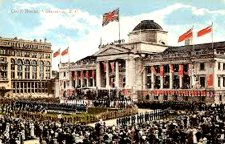 On September 18th, Canada’s Governor General, the Duke of Connaught (a famous soldier and a son of Queen Victoria), visited Vancouver with the Duchess to officiate at the ceremony naming the brand-new Connaught Bridge—a name that never caught on. Everyone called it the Cambie Street Bridge. (It was demolished in 1985, replaced by the present bridge.) The royals were accompanied by their daughter, Princess Patricia, the woman for whom the Princess Patricia’s Canadian Light Infantry (PPCLI) is named; she was the regiment’s colonel-in-chief.
On September 18th, Canada’s Governor General, the Duke of Connaught (a famous soldier and a son of Queen Victoria), visited Vancouver with the Duchess to officiate at the ceremony naming the brand-new Connaught Bridge—a name that never caught on. Everyone called it the Cambie Street Bridge. (It was demolished in 1985, replaced by the present bridge.) The royals were accompanied by their daughter, Princess Patricia, the woman for whom the Princess Patricia’s Canadian Light Infantry (PPCLI) is named; she was the regiment’s colonel-in-chief.
The Connaughts officially opened the provincial courthouse, too. James Findlay was the first Vancouver mayor to wear the new gold civic chain of office. That was for the royal visit.
 Also in 1912, the Lee Building at Broadway and Main went up. That’s the one with the huge billboard atop it. The CPR Station opened at 601 West Cordova. Contractor was Westinghouse, Church, Kerr & Co. Today the beautiful old building is the western terminus for the SkyTrain and the West Coast Express, and the southern port for the SeaBus. Charlie Chaplin and Stan Laurel performed in Vancouver with a music hall troupe from England, “Karno's Comedians.” A 250-pound Vancouver policeman, Duncan Gillis, became the first Olympic medal winner from B.C., winning silver at Stockholm in the hammer throw. (48.39 metres.)
Also in 1912, the Lee Building at Broadway and Main went up. That’s the one with the huge billboard atop it. The CPR Station opened at 601 West Cordova. Contractor was Westinghouse, Church, Kerr & Co. Today the beautiful old building is the western terminus for the SkyTrain and the West Coast Express, and the southern port for the SeaBus. Charlie Chaplin and Stan Laurel performed in Vancouver with a music hall troupe from England, “Karno's Comedians.” A 250-pound Vancouver policeman, Duncan Gillis, became the first Olympic medal winner from B.C., winning silver at Stockholm in the hammer throw. (48.39 metres.)
Most of us have grown up with Oreo cookies, and 100 years ago the Oreo cookie, was born. In 1912, Nabisco had a new idea for a cookie - two chocolate disks with a creme filling in between. The first Oreo cookie looked very similar to the Oreo cookie of today, with only a slight difference in the design on the chocolate disks.
 So how did the Oreo get its name? The people at Nabisco aren't quite sure. Some believe that the cookie's name was taken from the French word for gold, "or" (the main color on early Oreo packages). Others claim the name stemmed from the shape of a hill-shaped test version; thus naming the cookie in Greek for mountain, "oreo." Still others believe the name is a combination of taking the "re" from "cream" and placing it between the two "o"s in "chocolate" - making "o-re-o." And still others believe that the cookie was named Oreo because it was short and easy to pronounce.
So how did the Oreo get its name? The people at Nabisco aren't quite sure. Some believe that the cookie's name was taken from the French word for gold, "or" (the main color on early Oreo packages). Others claim the name stemmed from the shape of a hill-shaped test version; thus naming the cookie in Greek for mountain, "oreo." Still others believe the name is a combination of taking the "re" from "cream" and placing it between the two "o"s in "chocolate" - making "o-re-o." And still others believe that the cookie was named Oreo because it was short and easy to pronounce.
No matter how it got named, over 362 billion Oreo cookies have been sold since it was first introduced in 1912, making it the best selling cookie of the 20th century.
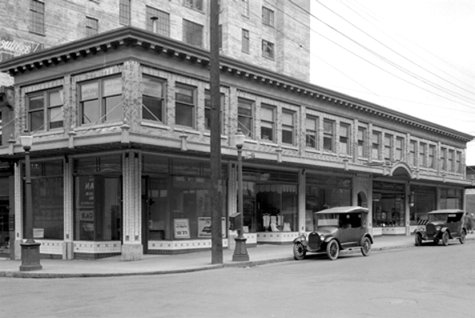
In 1903 Mrs Thrythall was listed in the Building Permit Register owner, architect and developer of a frame store and dwelling at the corner of Dunsmuir and Seymour. Her husband, William, was one of the earlier printers in the city, setting up shop in 1888 with his son, also called William. The 1903 insurance map shows the corner developed with a printers office (electric motor) with offices above. The additions seem to have been further east, along Dunsmuit Street. The family name is recorded as both Thrythall and Trythall, so there’s some confusion, but Trythall seems to be correct. The company was still operating from the Seymour address in 1920, although a year later they have moved to Homer Street. Most history associated with the family is connected to Mt Trythall’s cabin, halfway up Grouse Mountain – when a climb to the summit took three days to accomplish.
Some time in the mid to late 1920s when this picture is thought to have been taken a new building was erected. It’s identified by the City Archives as the Lawsen Building – although there don’t seem to be any residents of the city called Lawsen in the late 1920s or early 1930s. But there was a Viggo Laursen, who was a solicitor for the BC Electric Railway Co, and he seems to be the likely owner. Viggo was born in Denmark but had arrived in 1893 with his parents, John and Mary, joining his brother, Otto, a plumber, who had arrived two years earlier. We’ve failed so far to identify the architect or builder.
By 1932 The Railway Club began as a members only card club for railway workers. Known initially as the Railwaymen’s Club, it was one of many membership only workingman clubs opened in the city after prohibition was lifted. The club occupied space once occupied by the European Concert Cafe on the upper floors of the Laursen Building. The club operated with a rare “red circle” license where card clubs like the Marine Club and Logger’s Social Club were given a choice by the government, stop the cards or the sale of liquor. Today the Railway Club continues to operate as a bar and live music venue with one of the most eclectic selections of music in the city.
Source: Changing Vancouver
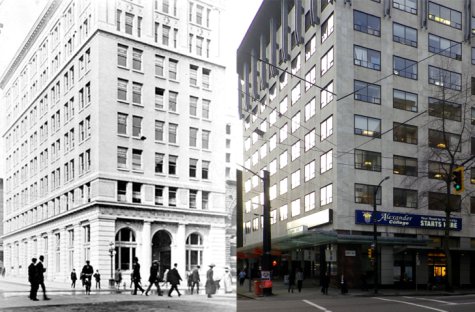
Here’s the Bank of Ottawa on the corner of Seymour and West Hastings in 1912. The new eight storey building was designed by W Marbury Somervell, but probably slightly changed by Somervell and Putnam (as it has a 1911 building permit in their name). It cost $225,000, and pictures of the construction show a reinforced concrete frame rather than all steel. The building bears a very strong resemblance to the BC Securities Building which is three blocks away and completed a year later to HS Griffith’s design.
The speed that construction could be completed on commercial buildings can be seen from the Contract Record report of September 1910. Work was just starting on the building site, clearing the existing buildings and excavating the basement, and it was expected the whole thing would be complete by May 1911, with occupancy coming a month later. There were 16 offices per floor above the banking floor, and the quality of the building was obviously aimed at all the other office buildings competing for tenants “The entrance to the vestibule and lobby will be handsomely done in marble, while the floors above will be trimmed throughout in birch and finished with mahogany. Other features of this latest addition to Vancouver’s tall buildings will be a vacuum heating system throughout, hot and cold water in all the offices, the Durham plumbing system, mail chute equipment, vacuum cleaning system for all the offices, and commodious toilet rooms on every floor.” The successful contracting bid came from McDonald and Wilson who started work in October 1910 and as far as we know completed on time.
In 1919 the Bank of Ottawa were merged with the Bank of Nova Scotia, and it stayed a branch of the new owners for over 30 years. In 1956 noted local architects Sharp, Thompson, Berwick and Pratt were given the design job of enlarging the bank building. The new project stripped the old building to its frame, replaced the small tobacco store with the billiards room behind (The Maple Leaf Club in 1946) that was next door and the restaurant with rooms over beyond that, and created a simple new office building which was nearly twice the size of the original. A more recent building upgrade in 1987 added an elegant projecting metal cornice to the building.
Source: Changing Vancouver
Vancouver Architects have designed some spectacular buildings over the past century, solving problems along the way and creating solutions that have made a lasting impression on the city. Here are a few well remembered structures and businesses that no longer grace our city.
A Postcard View From the Roof of the 2nd Hotel Vancouver
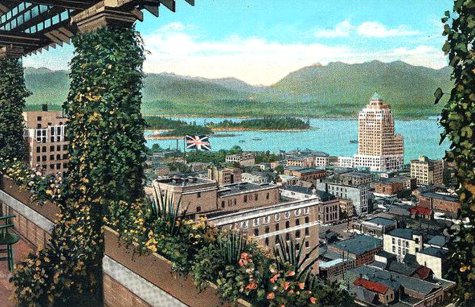
The Pier at English Bay
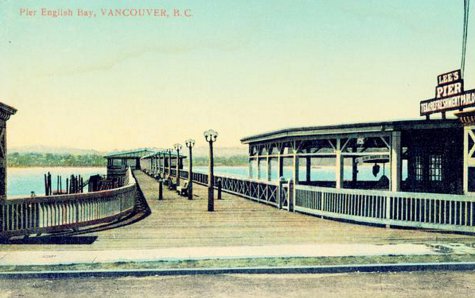
The Pantages Theatre
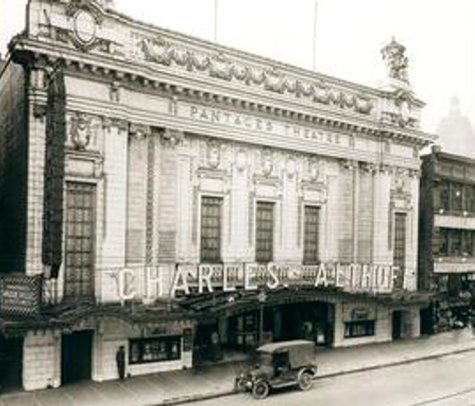
The Vancouver Opera House
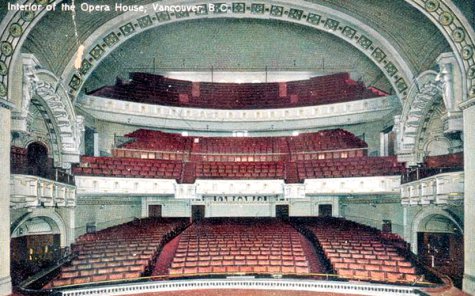
The Cave Supper Club
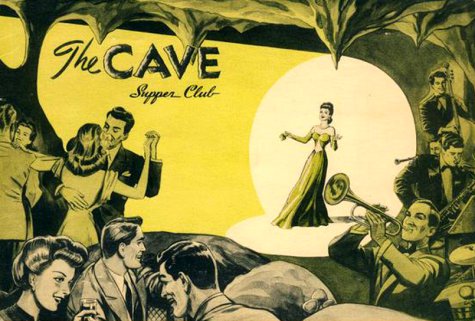
The Original Stanley Park Entrance
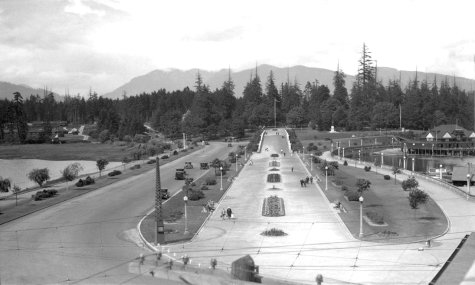
Expo 86
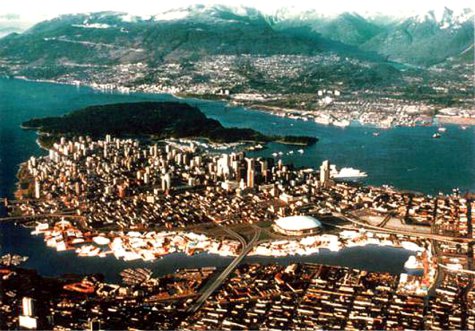
The Vancouver Grizzlies

Canadian Pacific Airlines
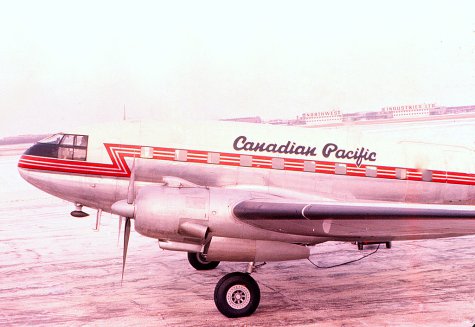
The 2nd Cambie Street Bridge
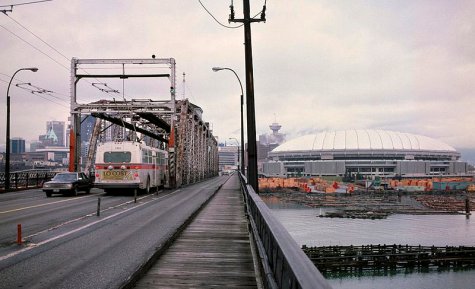
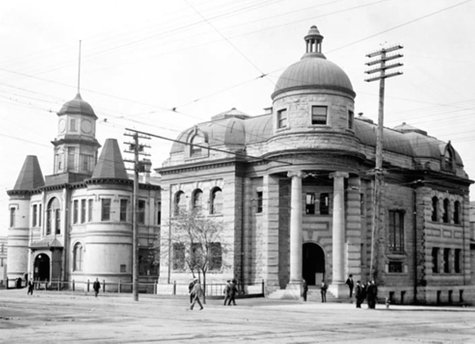
By the late 1890s the city was in need of a library - a real library rather than a room in another building. American philanthropist Andrew Carnegie was funding libraries all over North America, and Vancouver was viewed favourably for an investment in literature. (There were 125 Carnegie Libraries in Canada, almost all in Ontario, but Victoria and New Westminster got one too). G W Grant was hired to design the building, which was most definitely outside the CPR part of town, on the south-west corner of Westminster (Main) and Hastings. Carnegie donated $50,000 on the basis that the City would donate a site and spend $5,000 a year on running the library.
Work started in 1902 and nearly two years later the library opened. It was located next door to the new City Hall. An earlier City Hall was located at Powell Street in 1888. In 1898 the City moved to the building you can see to the south of the library. It was originally erected in 1889 as a market hall designed by C O Wickenden. It was built of Bowen Island bricks where Mayor David Oppenheimer had a financial interest in the brickworks. Unfortunately the clay, or the firing, wasn’t the finest, and Wickenden had to hastily change the design to add two buttressing towers to make sure the building stayed up.
In 1929 with the amalgamation of two other cities into Vancouver larger premises were needed and Council decamped to the Holden Building, an existing office also altered to become City Hall.
The Library stayed until the early 1950s, taking over the former City Hall as an Annex. After the Library moved to their new building on Burrard Street the Museum used the Carnegie building, and the old City Hall was demolished in 1958. After threats of demolition the renovated Carnegie Centre opened as a social service centre for the Downtown Eastside in 1980, incorporating a branch library and with a subtle addition designed by Downs Archambault to the south.
Image source: Library and Archives Canada
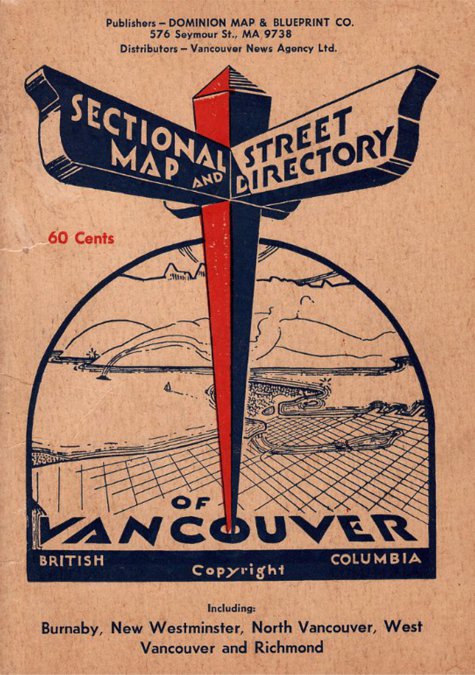
The Sectional Map and Street Directory was the brainchild of a man named Robert Morton. Morton was born in Glasgow, Scotland in 1856. He immigrated to Winnipeg in 1911, then moved to Vernon, BC, for about five years, and then to Calgary.
In 1931-32 Morton moved to Vancouver and took up residence at 2119 Maple Street. He began publishing a section map booklet and street index of the city because an ordinary map of Vancouver was too bulky to carry around. The booklet covered Vancouver, Burnaby, New Westminster, North Vancouver, West Vancouver, Surrey, Maillardville, Lulu Island, and Sea Island. Morton himself went door to door selling his booklets, and was still doing so at the age of 87 in 1942.
Of course maps are full of street names, and where exactly did all those street name come from? Who was Hastings Street named for? How about Hornby? Or what’s the story behind the naming of Charles Street? Now, thanks to the Vancouver Historical Society, which commissioned the work from Elizabeth Walker, and to the Vancouver Public Library, which has put it on line, you can get the answers to those and other questions. Click Here »
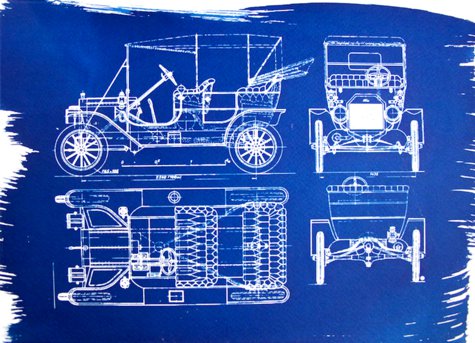
The cyanotype process, also known as the blue print process was invented by Sir John Herschel in 1842 and is still performed today by many darkroom enthusiasts. Herschel made numerous important contributions to photography. He made improvements in photographic processes, particularly in inventing the cyanotype process and variations (such as the chrysotype), the precursors of the modern blueprint process. He experimented with color reproduction, noting that rays of different parts of the spectrum tended to impart their own color to a photographic paper. He collaborated in the early 1840s with Henry Collen, portrait painter to Queen Victoria. Herschel originally discovered the platinum process on the basis of the light sensitivity of platinum salts, later developed by William Willis.
In 1861 Alphonse Louis Poitevin, a French chemist, found that ferro-gallate in gum is light sensitive. Light turns this to an insoluble permanent blue. A coating of this chemical on a paper or other base may be used to reproduce an image from a translucent document.
The ferro-gallate is coated onto a paper from aqueous solution and dried. The coating is yellow. In darkness it is stable for up to three days. It is clamped under glass and a light transmitting document in a daylight exposure frame, which is similar to a picture frame. The frame is put out into daylight requiring a minute or two under a bright sun or about ten times this under an overcast sky. Where ultra-violet light is transmitted the coating converts to a stable blue or black dye. The image can be seen forming, when a strong image is seen the frame is brought indoors and the unconverted coating, under the original image, is washed away. The paper is then dried.
The result is a copy of the original image with the clear background area rendered dark blue and the image reproduced as a white line. The image is stable.
Later other blueprint processes based on photosensitive ferric compounds were used. The best known is probably a process using ammonium ferric citrate and potassium ferricyanide. In this procedure a distinctly blue compound is formed and the process is also known as cyanotype. The paper is impregnated with a solution of ammonium ferric citrate and dried. When the paper is illuminated a photoreaction turns the trivalent (ferric) iron into divalent (ferrous) iron. The image is then developed using a solution of potassium ferricyanide forming insoluble ferroferricyanide (Turnball's blue identical to Prussian blue) with the divalent iron. Excess ammonium ferric citrate and potassium ferricyanide are then washed away.
This is a simple process for the reproduction of any light transmitting document. Engineers and architects drew their designs on cartridge paper; these were then traced on to tracing paper using Indian ink for reproduction whenever needed.
Traditional blueprints have largely been replaced by more modern, less expensive printing methods and digital displays. In the early 1940s, cyanotype blueprint began to be supplanted by diazo prints or whiteprints, which have blue lines on a white background; thus these drawings are also called blue-lines or bluelines. Other comparable dye-based prints are known as blacklines.
Diazo prints remain in use in some applications but in many cases have been replaced by xerographic print processes similar to standard copy machine technology using toner on bond paper. More recently, designs created using Computer-Aided Design techniques may be transferred as a digital file directly to a computer printer or plotter; in some applications paper is avoided altogether and work and analysis is done directly from digital displays. Another common modern method of copying is the use of large-format scanners. These digitize an image which can then be printed with a large-format plotter.
As print and display technology has advanced, the traditional term "blueprint" has continued to be used informally to refer to each type of image.
Source: Wikipedia.org
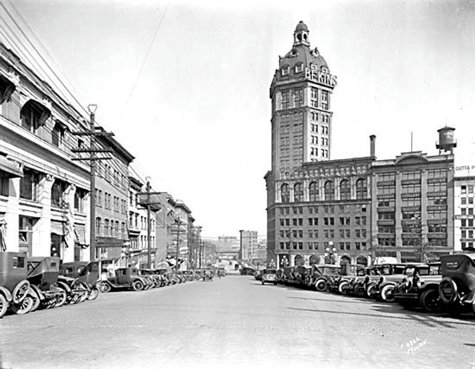
In 1912 Dominion Blue Print & Drafting Company makes its debut in the city directory. It is one of eight companies involved in blueprints. A half page ad on page 226 of the 1912 directory indicates that Dominion Blue Print & Drafting Company, located at 36 Bank of Hamilton Building (432 Hamilton St.), is a Maker of Maps, Blueprints, Brown Line, and Blue Line Prints. Horace N. Clarke is listed as the Manager.
The newly completed World Building, located at the corner of Pender and Beattie Streets, was commissioned by L. D. Taylor to house his newspaper, The Vancouver World. It was designed by architect W. T. Whiteway, who also designed the original Woodward's building nearby. The intention was that the building would be visible throughout the World's circulation area as the tallest building in the city. John Coughland and Sons of Vancouver had 1,250 tons of steel fabricated for construction.
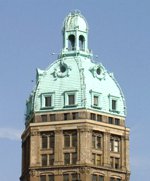 It is known for its faux-patina steel dome painted to imitate copper cladding. Nine nude muses, the "nine maidens" supporting the cornice line can be seen. The terracotta for this building, including the ladies, was made in Tamworth, Staffordshire, England by Gibbs and Canning Limited.
It is known for its faux-patina steel dome painted to imitate copper cladding. Nine nude muses, the "nine maidens" supporting the cornice line can be seen. The terracotta for this building, including the ladies, was made in Tamworth, Staffordshire, England by Gibbs and Canning Limited.
When it was completed in 1912, it was called The World Building and was the tallest building in the British Empire at 82 m (269 ft), surpassing the previous record-holder, the Dominion Building located just around the corner. For two years, it was the tallest building in Canada until Toronto's 20-story Optima Business Centre opened in 1914. In 1918, droves of Vancouverites turned out to watch as Harry Gardiner, the "Human Fly", scaled the outside of the building. When The Vancouver Sun bought the building in 1937, it was renamed. Although The Sun newspaper has long since relocated, first to South Granville then to Granville Square, the building has retained the name.
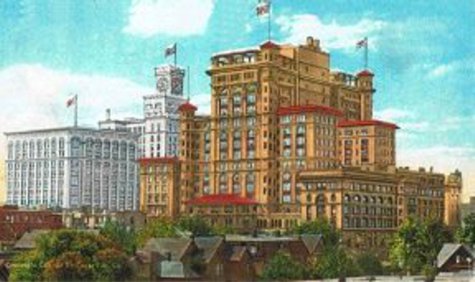
The history of the redevelopment of the second Hotel Vancouver is surprisingly complicated. The CPR opened the first hotel in 1888. In 1893 they added a new wing known as the Van Horne wing on Granville Street, and then another completed around 1904 on Georgia Street at a cost of $100,000. This was designed with the intent of setting the style of the new, much larger hotel. By 1908 Eric Nicol noted that the Hotel “had 205 rooms, 75 with bath connections – a ratio bordering on hedonism”.
In 1910 the CPR excavated on Howe Street and in early 1911 built Honeyman and Curtis’s Annex. Meanwhile, at the end of 1910 the new CPR architect W S Painter obtained a building permit for an addition to the hotel. In January 1912 it was reported that a $1,000,000 14-storey replacement hotel would be built for the CPR. It wouldn’t just fill the Granville and Georgia corner, it filled the block all the way back to Robson and Howe.
In May, 1912 under the headline, To Start work on CPR Hotel in Fall’ the Contract Record said "The latest advices from Montreal by the C P R in Vancouver state that the board of directors of the railway company have approved an appropriation of $1,200,000 for the proposed reconstruction of the Hotel Vancouver, and another $215,000 for the power plant in connection with the hotel.
The main hotel building will occupy the site of the hotel office or central section and will be extended south as far as the Opera House lane. It will be at least twelve stories in height, and two additional stories will be added to the Georgia Street wing completed about eight years ago.
When completed the hotel, it is said, will have the largest ground floor corridors of any hotel in existence. Construction will be started late this fall as soon us the rush of tourists is over. The plans are now being prepared by Painter & Swale, Metropolitan bldg."
In October the Daily Building Record reported “Plans were filed with the building inspector yesterday for the proposed rebuilding of the Hotel Vancouver, corner of Georgia and Granville Streets, at a cost of $800,000. The structure will be of steel and concrete with terra cotta facings.
The building will be heated by steam and all of the partition walls will be fireproof. Hardwood floors are specified, also 3 passenger elevators and one for freight. The central portion of the bldg will be 14 storeys in height with wings on either side, the New Orpheum theatre, which is now being erected, being in the nature of a wing to correspond with the railway company’s main hotel bldg. Painter & Swales, Metropolitan bldg. are the architects. A contractor has not been set as yet.”
By November 1912 the architects (who had moved offices) were looking for suppliers of the terra cotta and the steel contract was let to J. Coughlin at a cost of $200,000. Then everything slowed down. In 1913 reports covered a revised version of the plans “The Canadian Pacific Railway recently deposited plans for four additional storeys to the central portion of the Hotel Vancouver, Vancouver, and for the east wing fronting on Granville street, at an estimated cost of $1,100,000. The estimated outlay on the work of reconstructing the central portion of the hotel, calling for twelve storeys, was $800,000, so that with the addition of the work now proposed, the ultimate cost will not be far short of $2,000,000. According to the plans, the central part of the structure will be sixteen storeys in height, and the east wing will be eleven storeys, with the exception of the centre, midway between Georgia street and the Orpheum theatre. Here a large hall will be situated, for banquet purposes. The entrance to this hall will be 87 feet by 59 feet, and will be from Granville street. The whole structure will be of reinforced concrete and steel construction, faced with pressed brick.” Painter and Swales obtained another permit – this one for $1,100,000, and construction started. The various replacement sections, additions and the extra height were now said to be costing $2,500,000. By the time the project was being built the architect was Francis Swales; like Francis Rattenbury who was the initial choice for the new hotel, W S Painter had abandoned the task.
Even then, everything wasn’t complete. The Granville Street wing was the last to be added, replacing the Van Horne wing, and completed in 1916. The company confirmed that year they would be adding 250 more rooms but not until the war was over. The company said the hotel had already cost $3,000,000 and the addition would cost $750,000 more. That part of the project never happened. Even as it was being planned, a long term future of the project was in doubt. In the meantime, the most remarkable and expensive building that the city had seen was open for business, with fabulous views out to the north shore mountains from the sixteenth storey roof garden and terrace.
In 1928 construction begins on the Hotel British Columbia (the current Hotel Vancouver). It was not completed until 1939.
Source: Changing Vancouver
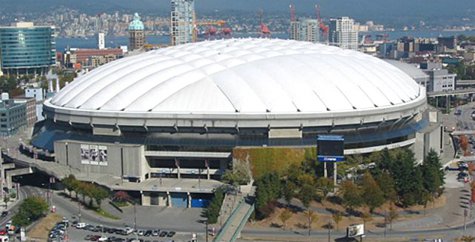
In 1983, B.C. Place, the largest air-supported stadium in North America, is completed. The stadium covers 10 acres. The Grey Cup game between the Toronto Argonauts and the BC Lions was played in front of 59,345 football fans at BC Place Stadium, with the Argonauts winning their first Grey Cup since 1952 with a final score of 18 to 17.
The 1983-84 listing for Dominion Blueprint & Reprographics offers some more detail on the company. It is a division of Dieterich Post Co. of Canada Ltd. John L. Bingham is the Vice President and Division Manager. The directory listing proudly declares that the people at Dominion Blueprint & Reprographics are "The Professionals Serving British Columbia".
The Vancouver office is still at 1533 West Pendar. The North Vancouver office is at 1348 Marine Drive. In 1986 the company is bought by John Bingham.
On January 3, 1986 the Expo Line of the Skytrain goes into regular service connecting Vancouver and New Westminster with state-of-the-art transit service.
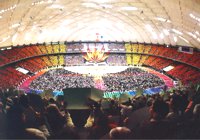 B.C. Place was used for the opening and closing ceremonies of the 1986 World Exposition on Transportation and Communication (Expo '86). Accepting an invitation by the Province of British Columbia, their Royal Highnesses Prince Charles and Princess Diana made themselves available to take part in the opening ceremonies. To great fanfare, they officially proclaimed the World's fair open on May 2, 1986.
B.C. Place was used for the opening and closing ceremonies of the 1986 World Exposition on Transportation and Communication (Expo '86). Accepting an invitation by the Province of British Columbia, their Royal Highnesses Prince Charles and Princess Diana made themselves available to take part in the opening ceremonies. To great fanfare, they officially proclaimed the World's fair open on May 2, 1986.
The opening and closing ceremonies of the XXI Olympic Winter Games and the opening ceremonies of the X Paralympic Winter Games were also held in BC Place Stadium in February and March 2010, respectively. The stadium was the first air-supported structure and 24th venue to host the opening ceremonies of the Winter Olympics.
The biggest and most visible improvement to B.C. Place is the recently completed retractable roof and a huge superstructure that will define the city’s skyline for decades to come.
The 50 best golfers of all time. How does one compare Old Tom Morris to Tiger Woods? Ben Hogan to Babe Zaharias? Jack and Arnold to anybody? It's a tough task until you just do the numbers. You can be sure of one thing; their focus on the game was unstoppable. In the same way we here at Dominion have been focused on our game since 1912.
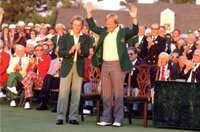 How many professional majors, how many pro tour victories, how many world wide victories even if it's the Legends of Golf or The Skins Game? Those were our measuring sticks. Amateur championships, if added, might change the order a little bit. But that's a task for someone else at another time. These are our top 50 playing in professional events.
How many professional majors, how many pro tour victories, how many world wide victories even if it's the Legends of Golf or The Skins Game? Those were our measuring sticks. Amateur championships, if added, might change the order a little bit. But that's a task for someone else at another time. These are our top 50 playing in professional events.
The first two slides are for historic golfers who shot scores like 54-56-53=163 to win early British Opens. That's not quite the same challenge as today's players face. However, they beat whoever showed up, and when the winning scores is 163, what was par? Was it just level 4s? It's a wonder we have the records at all.
 Still, it doesn't make sense to give them higher standing than some of the modern players who contested over 72 holes, on great courses, with tough competition and then won in many tournaments around the world. When you see who the modern era golfers are, you'll understand the reason for putting the historic gentlemen last. No disrespect meant.
Still, it doesn't make sense to give them higher standing than some of the modern players who contested over 72 holes, on great courses, with tough competition and then won in many tournaments around the world. When you see who the modern era golfers are, you'll understand the reason for putting the historic gentlemen last. No disrespect meant.
Click Here to View the Top 50 Golfers of All Time.
Source: Bleacher Report / bleacherreport.com

The sun is shining and the seawall is already getting crowded, which can only mean one thing—summer is on its way. To further celebrate 100 years of doing business here in Vancouver here's Billboards list of the Top 30 "Summer" songs of all time along with our top summer time printing hits and solutions.
These 30 hot tunes with summer-specific themes are ranked based on each track's performance on the Billboard Hot 100 chart from August 4, 1958—the inception of the chart—through the chart dated May 28, 2011. Songs are ranked based on an inverse point system, with weeks at No. 1 earning the greatest value and weeks at No. 100 earning the least.
Click Here to view and listen to the Top 30. To find out more about ColourWave Printing Click Here, Indoor & Outdoor Signage Click Here, and ProCut Fabrication Click Here.